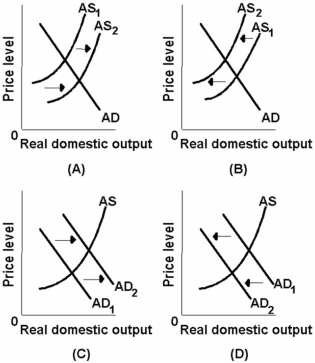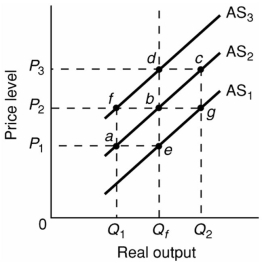A) 1 and 3
B) 2 and 4
C) 5 and 10
D) 8 and 9
Correct Answer

verified
Correct Answer
verified
Multiple Choice
The aggregate expenditures model and the aggregate demand curve can be reconciled because, other things being equal, in the aggregate expenditures model:
A) changes in the price level have no effect on the equilibrium level of GDP.
B) an increase in the price level increases the real value of wealth.
C) the level of aggregate expenditures and therefore the level of real GDP vary inversely with the price level.
D) the level of aggregate expenditures and therefore the level of real GDP vary directly with the price level.
Correct Answer

verified
Correct Answer
verified
Multiple Choice
Other things equal, an increase in the price level will:
A) shift the short run aggregate supply curve to the right.
B) shift the aggregate demand curve to the right.
C) cause a movement up along a short-run aggregate supply curve.
D) cause a movement down a short run aggregate supply curve.
Correct Answer

verified
Correct Answer
verified
Multiple Choice
In which of the following sets of circumstances can we confidently expect inflation?
A) aggregate supply and aggregate demand both increase
B) aggregate supply and aggregate demand both decrease
C) aggregate supply decreases and aggregate demand increases
D) aggregate supply increases and aggregate demand decreases
Correct Answer

verified
Correct Answer
verified
Multiple Choice
 -Which of the above diagrams best portrays the effects of an increase in productivity?
-Which of the above diagrams best portrays the effects of an increase in productivity?
A) A
B) B
C) C
D) D
Correct Answer

verified
Correct Answer
verified
Multiple Choice
Other things equal, an improvement in productivity will:
A) tend to increase the equilibrium price level.
B) shift the aggregate supply curve to the left.
C) shift the aggregate supply curve to the right.
D) shift the aggregate demand curve to the left.
Correct Answer

verified
Correct Answer
verified
Multiple Choice
Other things equal, appreciation of the dollar:
A) increases aggregate demand in Canada and may increase aggregate supply by reducing the prices of imported resources.
B) increases aggregate demand in Canada and may decrease aggregate supply by reducing the prices of imported resources.
C) decreases aggregate demand in Canada and may increase aggregate supply by reducing the prices of imported resources.
D) decreases aggregate demand in Canada and may reduce aggregate supply by increasing the prices of imported resources.
Correct Answer

verified
Correct Answer
verified
Multiple Choice
Suppose the full-employment level of real output (Q) for a hypothetical economy is $500 and that the price level (P) initially is 100. Use the following short-run aggregate supply schedules to answer the next question.
 -Refer to the information above. In the long run, an increase in the price level from 100 to 125 will:
-Refer to the information above. In the long run, an increase in the price level from 100 to 125 will:
A) increase real output from $500 to $560.
B) decrease real output from $500 to $440.
C) change the aggregate supply schedule from (a) to (c) and result in an equilibrium level of real output of $560.
D) change the aggregate supply schedule from (a) to (b) and result in an equilibrium level of real output of $500.
Correct Answer

verified
Correct Answer
verified
Multiple Choice
Refer to the list below. Which two factors would most likely cause a change in investment spending? The following list of items is related to aggregate demand. 
A) 2 and 5
B) 3 and 10
C) 2 and 7
D) 6 and 9
Correct Answer

verified
Correct Answer
verified
Multiple Choice
An increase in aggregate expenditures resulting from a decrease in the price level is equivalent to a:
A) rightward shift of the aggregate demand curve.
B) leftward shift of the aggregate demand curve.
C) movement downward along a fixed aggregate demand curve.
D) decrease in aggregate supply.
Correct Answer

verified
Correct Answer
verified
Multiple Choice
Refer to the diagram below. Assume that nominal wages initially are set on the basis of the price level P2 and that the economy initially is operating at its full-employment level of output Qf. In the short run, cost-push inflation could best be shown as: 
A) a leftward shift of aggregate supply from AS2 to AS3.
B) a move from b to c on AS2.
C) a move from b to c to d.
D) a move from b to f to d.
Correct Answer

verified
Correct Answer
verified
Multiple Choice
A n expected rise in the rate of inflation for consumer goods will:
A) decrease aggregate demand.
B) increase aggregate supply.
C) increase aggregate demand.
D) decrease aggregate supply.
Correct Answer

verified
Correct Answer
verified
Multiple Choice
If real output rises and the price level falls, this would likely be due to a:
A) rightward shift of the aggregate demand curve.
B) leftward shift of the aggregate demand curve.
C) rightward shift of the aggregate supply curve.
D) leftward shift of the aggregate supply curve.
Correct Answer

verified
Correct Answer
verified
Multiple Choice
Which would most likely shift the aggregate supply curve? A change in:
A) consumer expectations.
B) government spending.
C) excess capacity in business.
D) prices of imported resources.
Correct Answer

verified
Correct Answer
verified
Multiple Choice
An increase in aggregate demand is most likely to be caused by a decrease in:
A) the wealth of consumers.
B) consumer confidence.
C) business confidence.
D) the tax rates on household income.
Correct Answer

verified
Correct Answer
verified
Multiple Choice
The per unit cost of production in the economy described above is:
A) $.50.
B) $1.
C) $2.
D) $5.
Correct Answer

verified
Correct Answer
verified
Multiple Choice
Refer to the above diagram. If the price level rises above P1 because of an increase in aggregate demand, the:
A) economy will move up along curve B and output will temporarily increase.
B) long-run aggregate supply curve C will shift upward.
C) short-run aggregate supply curve B will automatically shift to the right.
D) economy's output first will decline, then increase, and finally return to Q1.
Correct Answer

verified
Correct Answer
verified
Multiple Choice
Suppose that nominal wages fall and productivity rises in a particular economy. Other things equal, the aggregate:
A) demand curve will shift leftward.
B) supply curve will shift rightward.
C) supply curve will shift leftward.
D) expenditures curve will shift downward.
Correct Answer

verified
Correct Answer
verified
Multiple Choice
 -Which of the above diagrams best portrays the effects of a dramatic increase in energy prices?
-Which of the above diagrams best portrays the effects of a dramatic increase in energy prices?
A) A
B) B
C) C
D) D
Correct Answer

verified
Correct Answer
verified
Multiple Choice
Refer to the above information. Given an increase in input price from $4 to $6, we would expect the aggregate:
A) supply curve to shift to the left.
B) supply curve to shift to the right.
C) demand curve to shift to the left.
D) demand curve to shift to the right.
Correct Answer

verified
Correct Answer
verified
Showing 81 - 100 of 195
Related Exams